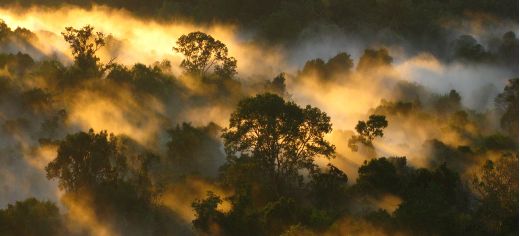
The most extensive land-based study of the Amazon to date reveals it is losing its capacity to absorb carbon from the atmosphere.
From a peak of two billion tonnes of carbon dioxide each year in the 1990s, the net uptake by the forest has halved and is now for the first time being overtaken by fossil fuel emissions in Latin America.
Over recent decades the remaining Amazon forest has acted as a vast ‘carbon sink’ – absorbing more carbon from the atmosphere than it releases – helping to put a brake on the rate of climate change. But this new analysis of forest dynamics shows a huge surge in the rate of trees dying across the Amazon.
Initially, an increase in carbon dioxide in the atmosphere – a key ingredient for photosynthesis – led to a growth spurt for the Amazon’s trees, the researchers say. But the extra carbon appears to have had unexpected consequences.
Study co-author Professor Oliver Phillips, also from the University’s School of Geography, said: “With time, the growth stimulation feeds through the system, causing trees to live faster, and so die younger.”
Recent droughts and unusually high temperatures in the Amazon may also be playing a role. Although the study finds that tree mortality increases began well before an intense drought in 2005, it also shows that drought has killed millions of additional trees.
Dr Brienen said: “Regardless of the causes behind the increase in tree mortality, this study shows that predictions of a continuing increase of carbon storage in tropical forests may be too optimistic.
“Climate change models that include vegetation responses assume that as long as carbon dioxide levels keep increasing, then the Amazon will continue to accumulate carbon. Our study shows that this may not be the case and that tree mortality processes are critical in this system.”
To calculate changes in carbon storage they examined 321 forest plots across the Amazon’s six million square kilometres, identified and measured 200,000 trees, and recorded tree deaths as well as growth and new trees since the 1980s.
Image 1 (shown above): Amazon canopy at dawn, Brazil.
Credit: Peter van der Sleen
Image 2: Measuring Amazon trees, Peru.
Credit: Roel Brienen
Image 3: Flying buttresses prevent tree wind-throw, Colombia.
Credit: Peter Vitzum
Image 4: RAINFOR team monitoring the Amazon canopy, Peru.
Credit: Kuo-Jung Chao
Image 5: A map of the plots in the Amazon where tree measurements were taken for the study.
RAINFOR (www.rainfor.org) unites hundreds of scientists dedicated to monitoring Amazon ecosystems from the ground-up. The network is centred on permanent forest plots that track the lives of individual trees and species. The network emphasises careful, long-term, on-the-ground research to assess the behaviour of the world’s most active carbon exchange system, and to understand the impact of Amazonia on the global climate. RAINFOR also fosters the development of young scientists and field technicians, working closely with partners across the nations of Amazonia to help develop new generations of Amazon ecologists. The work of RAINFOR is currently supported by funding agencies in Brazil, Colombia, Peru, Venezuela, the UK (NERC), and the EU (European Research Council).
A full list of the 57 participating organisations from 15 countries is available at
www.rainfor.org.
Amazonia. At 6 million km2, the Amazon forest covers an area 25 times as great as the United Kingdom (or 15 times the size of California), and spans nine countries, or which by far the largest is Brazil. Large parts of Bolivia, Ecuador, Colombia, Peru, Venezuela, French Guyana, Guyana, and Suriname are also still covered by Amazon forests. This region contains one fifth of all species on Earth, including more than 15,000 tree species. Its three hundred billion trees store one fifth of all carbon in the Earth’s biomass. The Amazon is also home to several million people, and water vapour from Amazonia nurtures agriculture further south, including the biofuel crops which power Brazil’s cars. Each year Amazon forests cycle 18 billion tons of carbon, more than twice as much carbon as the combined emissions of all fossil fuels burnt in the world.